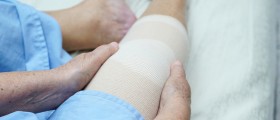
Introduction to torn knee ligament
A torn ligament in the knee can be a very uncomfortable and painful condition. There are four major ligaments in the knee that stabilize the joints and bones of that area of the leg.
These ligaments are strong elastic bands of tissue that connect two bones together.
They are crucial to balance and the weight bearing parts of the knee.
When the ligaments are injured it can be very painful and can limit mobility greatly. Symptoms
When someone tears a ligament in the knee, they might hear a popping sound or a snapping sound that indicates that the ligament has been torn. The knee might also buckle if the person puts weight on it.
This popping sound is usually heard when the ligament’s fibers are pulled apart.
Pain is another obvious symptom of this problem. Whether the ligament is completely or only partially torn, there will be pain involved. Of course, the severity of the pain depends on the severity of the injury.
Swelling and bruising is another result of a torn ligament. The soft tissue is irritated and then the area that surrounds the muscle tissue will swell. This happens as a result of the body increasing blood circulation and fluid flow to the spot of the injury.
Another common symptom is instability and limited movement. It will be very hard to move the knee or to put any weight on it when a ligament has been torn.
Treatment for torn knee ligament
The treatment depends on the seriousness of the injury. If the injury is not serious, then the injury can be dealt with at home and no surgeries will be needed.
It is important to give the knee rest and to protect it from any further ligament injuries.
Ice packs are good for decreasing the swelling and normalizing blood circulation in order to prevent swelling and inflammation.
It is important not to expose the skin to ice directly, but instead, to wrap it in a piece of cloth or towel before applying it to the knee.
It is also important not to keep the ice on the injury for more than 20 minutes at a time.
Compression is another good home remedy. Bandaging the injury will decrease swelling and speed up recovery.
Painkillers can be used to help with the pain that the torn ligament is causing, but it is best to first consult with a doctor regarding what type of pain medication is best for each individual.
It is important to keep the knee elevated at the level of the heart in order to speed up the recovery of the knee.
In very serious cases, a person will probably have to have reconstructive surgery in order to repair the damaged ligaments in the knee.

















Your thoughts on this
Loading...